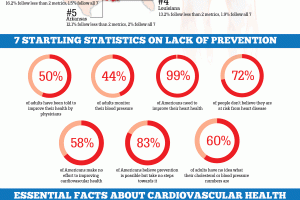The Heart of the Matter: Prioritizing Your Cardiovascular Health

Understanding Cardiovascular Health
Cardiovascular health encompasses the well-being of the heart and blood vessels, serving as the body’s vital circulatory system. With heart disease being a leading cause of death worldwide, understanding how to maintain good cardiovascular health is essential. This includes factors like blood pressure, cholesterol levels, and overall heart function. Have you ever noticed how your stress levels can affect your heart? Personally, I remember a time when I was overwhelmed with work, and my doctor highlighted how stress could contribute to high blood pressure. That conversation changed my perspective on managing my overall health.
- The Heart of the Matter: Prioritizing Your Cardiovascular Health
- Understanding Cardiovascular Health
- Importance of Prioritizing Your Heart Health
- Common Cardiovascular Conditions
- Hypertension
- Coronary Artery Disease
- Risk Factors for Heart Disease
- Smoking and Tobacco Use
- Poor Diet and Lack of Exercise
- Symptoms and Warning Signs
- Chest Pain
- Shortness of Breath
- Screening and Diagnosis
- Blood Pressure Measurement
- Cholesterol Levels Testing
- Lifestyle Changes for a Healthy Heart
- Balanced Diet
- Regular Physical Activity
- Medications for Cardiovascular Health
- Blood Thinners
- Statins
- Surgical and Interventional Treatments
- Angioplasty
- Bypass Surgery
- Managing Stress for a Healthy Heart
- Importance of Stress Management
- Relaxation Techniques
- Supporting Your Heart Health
- Family History Assessment
- Importance of Regular Check-ups
Importance of Prioritizing Your Heart Health
Prioritizing heart health can significantly improve one’s quality of life. Here are a few reasons why it’s crucial:
- Preventing Heart Disease: Early detection and lifestyle changes can help prevent complications.
- Enhanced Energy Levels: A healthy heart improves overall vitality.
- Longer Life Expectancy: Investing in your heart can lead to a longer, more fulfilling life.
Taking proactive steps towards understanding and improving cardiovascular health can empower individuals to lead healthier lives.
Common Cardiovascular Conditions
Hypertension
Hypertension, or high blood pressure, is often referred to as the “silent killer” because it typically shows no symptoms until it becomes severe. It’s essential to monitor this condition as it places extra strain on the heart and arteries. Many people, including myself, may not realize they have hypertension until a routine check-up reveals elevated readings. Some common lifestyle factors contributing to hypertension include:
- Excessive Salt Intake: High-sodium diets can trigger increased blood pressure.
- Lack of Physical Activity: Sedentary lifestyles often correlate with higher blood pressure.
- Stress: Chronic stress can lead to temporary spikes in blood pressure.
Managing hypertension can significantly reduce the risk of heart disease and stroke.
Coronary Artery Disease
Moving on to coronary artery disease (CAD), which develops when the coronary arteries become narrowed or blocked due to plaque buildup. This condition can lead to serious complications, including heart attacks. Some important signs and risk factors include:
- Chest Pain: Often described as pressure or discomfort.
- Risk Factors: Includes family history, smoking, and high cholesterol.
CAD emphasizes the importance of regular check-ups and lifestyle changes. For many, a simple dietary adjustment or increased physical activity can make a significant difference in heart health. Understanding these conditions can empower individuals to take charge of their cardiovascular well-being.
Risk Factors for Heart Disease
Smoking and Tobacco Use
When discussing risk factors for heart disease, smoking and tobacco use top the list. The harmful chemicals in tobacco can damage blood vessels, increase blood pressure, and reduce oxygen in the blood. Personally, my friend quit smoking recently after learning that it was taking a toll on her heart health. Here are a few compelling reasons why quitting is crucial:
- Immediate Benefits: Blood pressure decreases within 20 minutes of quitting.
- Long-Term Gains: Quitting reduces the risk of coronary heart disease by about 50% within a year.
These positive changes can inspire those still smoking to consider quitting.
Poor Diet and Lack of Exercise
Another significant risk factor is a poor diet coupled with a sedentary lifestyle. Many people, myself included, have experienced how fast food and convenience meals can lead to unhealthy weight gain and nutritional deficiencies. Consider incorporating these healthy habits:
- Balanced Diet: Focus on fruits, vegetables, whole grains, and lean proteins.
- Regular Exercise: Aim for at least 150 minutes of moderate-intensity activity each week.
These changes not only enhance heart health but also foster a more vibrant and energetic lifestyle. Understanding these risk factors can motivate individuals to make informed choices for better heart health.
Symptoms and Warning Signs
Chest Pain
Chest pain is one of the most recognizable symptoms related to heart issues, yet it’s a signal that many people overlook. This discomfort can vary from a sharp, stabbing sensation to a persistent pressure that feels like an elephant sitting on your chest. During a stressful time in my life, I remember experiencing unusual chest tightness after climbing a few flights of stairs. Understanding the possible implications was crucial. Here are some red flags to consider:
- Duration: Pain lasting more than a few minutes should be evaluated.
- Accompanying Symptoms: Nausea, sweating, or dizziness should not be ignored.
Regardless of age or fitness level, it’s essential to seek immediate medical advice if chest pain occurs.
Shortness of Breath
Another concerning symptom is shortness of breath, which can occur during physical activity or even at rest. This can be a sign that the heart isn’t pumping effectively or that the lungs aren’t functioning properly. I recall a friend who dismissed her shortness of breath as mere fatigue, only to discover later that she had underlying heart issues. Key points to recognize include:
- Change in Activity Levels: If previously manageable activities now cause breathlessness.
- Severity: Sudden onset, especially when accompanied by chest pain, requires urgent attention.
Understanding these symptoms can empower individuals to act swiftly and seek medical help, potentially saving lives in the process. Recognizing these warning signs is key to maintaining heart health.
Screening and Diagnosis
Blood Pressure Measurement
Screening for hypertension is a crucial step in understanding cardiovascular health. Regular blood pressure measurements can reveal invaluable information about your heart, often preceding significant issues. During a routine check-up a few years ago, I was surprised to discover my blood pressure reading was above normal. This prompted changes in my diet and exercise routine that ultimately improved my health. Here are key things to know about blood pressure measurement:
- Frequency: Adults should have their blood pressure checked at least once every two years.
- Optimal Range: A normal reading is typically around 120/80 mmHg.
Keeping track of blood pressure can be an effective way to prevent heart disease.
Cholesterol Levels Testing
Another essential diagnostic tool is cholesterol testing, which helps measure levels of various types of cholesterol in the blood. High levels of low-density lipoprotein (LDL) cholesterol can lead to plaque buildup in arteries, increasing the risk of heart disease. I recall discussing my cholesterol levels with my doctor, who emphasized the importance of a healthy balance. Here are some useful tips regarding cholesterol testing:
- Frequency: Adults should have their cholesterol levels checked every 4-6 years, starting at age 20.
- Ideal Levels: Aim for an LDL level of less than 100 mg/dL and a high-density lipoprotein (HDL) level of 60 mg/dL or higher.
Understanding your cholesterol levels and blood pressure is vital in maintaining heart health and preventing potential complications. These screenings can guide necessary lifestyle changes.
Lifestyle Changes for a Healthy Heart
Balanced Diet
Adopting a balanced diet is one of the most impactful lifestyle changes you can make for heart health. A nutritious diet not only helps manage weight but also lowers the risk of heart disease. Reflecting on my own journey, implementing more whole foods like fruits, vegetables, and whole grains has made a significant difference in my energy levels. Here are some key components of a heart-healthy diet:
- Healthy Fats: Incorporate sources like avocado, nuts, and olive oil while avoiding trans fats.
- Limit Salt and Sugar: Reducing sodium and added sugars can lower blood pressure and minimize weight gain.
- Portion Control: Practicing mindful eating helps maintain a healthy weight.
Regular Physical Activity
In conjunction with a balanced diet, regular physical activity is essential for sustaining a healthy heart. Exercise strengthens the heart muscle, improves circulation, and reduces stress—all vital for heart health. I’ve found that even short bursts of activity, like a brisk 30-minute walk, can uplift my mood and health. Some recommendations include:
- Aim for Consistency: Set a goal of at least 150 minutes of moderate-intensity exercise per week.
- Mix it Up: Incorporate a variety of activities, like walking, swimming, or dancing, to keep things interesting.
Making these lifestyle changes for a balanced diet and regular physical activity can lead to a healthier heart and a vibrant life. The journey toward heart health is not just beneficial; it’s transformative!
Medications for Cardiovascular Health
Blood Thinners
When it comes to managing cardiovascular health, blood thinners play a vital role in preventing blood clots, which can lead to serious conditions like heart attacks and strokes. These medications—often prescribed for individuals with a higher risk of clot formation—help keep the blood flowing smoothly. I remember a family member who was prescribed blood thinners after a minor heart scare. Some important things to note about blood thinners include:
- Types: Common options include warfarin and newer medications like rivaroxaban and apixaban.
- Monitoring: Regular blood tests are essential to ensure the dosage is appropriate, particularly for older medications like warfarin.
Consistent communication with healthcare providers is critical for anyone on blood thinners to avoid complications.
Statins
Statins are another class of medication widely used to lower cholesterol levels in the blood, thus reducing the risk of heart disease. I recall when my doctor recommended statins after discussing my cholesterol levels—initially, I was apprehensive, but understanding their benefits eased my concerns. Key points about statins include:
- Effectiveness: They work by blocking a substance your body needs to make cholesterol, effectively lowering LDL cholesterol levels.
- Common Types: Examples include atorvastatin, simvastatin, and rosuvastatin.
- Potential Side Effects: While typically well-tolerated, some may experience muscle aches or digestive issues.
Incorporating medications like blood thinners and statins into a comprehensive cardiovascular health plan can significantly improve outcomes, especially when paired with lifestyle changes. The journey to a healthier heart involves a combination of efforts!
Surgical and Interventional Treatments
Angioplasty
Angioplasty is a minimally invasive procedure used to open up blocked or narrowed arteries, significantly improving blood flow to the heart. I recall a close friend who underwent angioplasty after experiencing persistent chest pain. The entire procedure took less than an hour, and she was amazed by how quickly her symptoms resolved. Here are some key aspects of angioplasty:
- Procedure Overview: A thin catheter with a balloon at the tip is inserted into the affected artery. The balloon is inflated to widen the artery, often followed by placing a stent to keep it open.
- Recovery: Most patients can go home the same day or the next day and quickly return to light activities.
Angioplasty can be a lifesaving option for many individuals with coronary artery disease.
Bypass Surgery
Bypass surgery, or coronary artery bypass grafting (CABG), is a more extensive surgical procedure that reroutes blood around blocked arteries. It’s often recommended for patients with severe heart disease who may not benefit from angioplasty alone. Reflecting on a family member’s experience, I learned just how transformative this procedure can be. Here are some important points to consider:
- Procedure Process: Surgeons take a healthy blood vessel from another part of the body to create a new pathway for blood to flow to the heart.
- Recovery Time: The recovery period is longer compared to angioplasty, typically ranging from several weeks to months, but the improvement in quality of life can be profound.
Both angioplasty and bypass surgery are essential tools in the fight against heart disease, often allowing individuals to reclaim their health and vitality following treatment. Understanding these options can empower patients in their journey towards better cardiovascular health.
Managing Stress for a Healthy Heart
Importance of Stress Management
Managing stress is crucial for maintaining a healthy heart, as chronic stress can lead to high blood pressure, irregular heart rhythms, and even heart attacks. I remember when my workload surged and caused me constant anxiety; my doctor emphasized the link between my stress levels and heart health. Effective stress management can help mitigate these risks. Here are some reasons why it’s important:
- Reduced Heart Rate: Effective stress management can help lower heart rates and promote relaxation.
- Lower Blood Pressure: Managing stress aids in keeping blood pressure within a healthy range.
- Enhanced Lifestyle Choices: When stress is controlled, individuals are more likely to engage in healthy behaviors, like exercise and balanced eating.
Relaxation Techniques
Incorporating relaxation techniques into daily life can make a world of difference. I found that practicing mindfulness not only calmed my mind but improved my overall well-being. Some effective relaxation techniques include:
- Deep Breathing: This simple yet powerful technique can help reduce tension and promote a sense of calm.
- Meditation: Spending just a few minutes daily in meditation can lower stress levels significantly.
- Yoga: Combining physical movement with breath control and mindfulness, yoga is an excellent way to alleviate stress.
By prioritizing stress management and integrating these relaxation techniques, individuals can take proactive steps towards achieving better heart health. It’s a journey worth taking for both mental and physical wellness!
Supporting Your Heart Health
Family History Assessment
Supporting your heart health starts with understanding your family history. Genetic predisposition can play a significant role in heart disease risk. I learned this firsthand during a conversation with my doctor, who encouraged me to explore my family’s medical background. Some critical components to consider include:
- Cardiovascular Conditions: Identify if relatives have had heart attacks, strokes, or high blood pressure.
- Age of Onset: Knowing when family members experienced heart issues can help you and your doctor take proactive steps.
- Lifestyle Factors: Discuss ways in which your family’s lifestyle choices, such as diet and exercise, might influence your heart health.
By assessing your family history, you can be more proactive about monitoring risk factors and making informed choices to safeguard your heart.
Importance of Regular Check-ups
Regular check-ups serve as a cornerstone in supporting heart health. During my own routine exams, I’ve learned how valuable these visits are for early detection. Here’s why they matter:
- Early Detection: Regular visits allow for prompt identification of any emerging heart issues.
- Monitoring Risk Factors: Physicians can assess blood pressure, cholesterol levels, and other critical health markers.
- Guided Lifestyle Changes: Doctors offer personalized recommendations based on individual health profiles.
Consistent check-ups empower individuals to take control of their health and make necessary adjustments before small issues escalate. By combining family history insights with routine medical evaluations, individuals can effectively support their heart health for a brighter and healthier future.





